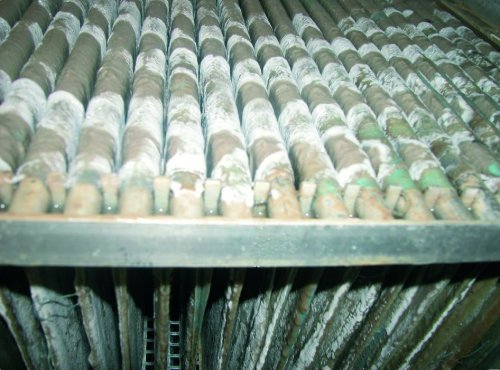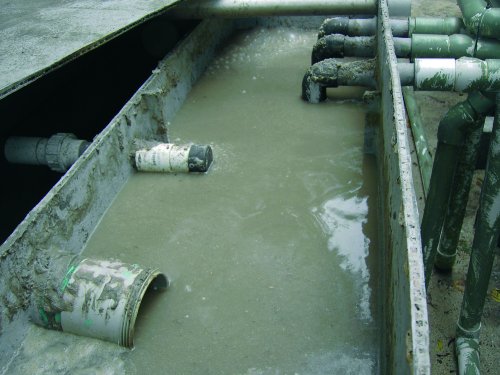Wastewater treatment for food manufacturers
Friday, 25 November, 2011
For many Australian and New Zealand food manufacturers there is increasing pressure from government agencies to reach higher standards of wastewater treatment for environmental discharge. In fact, throughout the western world, food manufacturers are facing similar challenges.
One of the big problems is the pipe networks, particularly sewage pipes, which are aging and industrial wastewaters with high sugar-nutrient loads can cause serious damage. This is because fermentation occurs within the wastewater, eroding and degrading the pipes, causing cracks and fractures. In turn, this leads to water ingress which puts a strain on the treatment plants because of the higher volumes of water, especially in wet weather.
Food manufacturing produces large volumes of mostly biodegradable liquid and solid waste. Wastewaters released from food manufacturing can be ‘muddy’, with high concentrations of suspended solids, fats, oils, grease and usually nutrients such as nitrogen, ammonia and phosphate.
The issue for many food manufacturers is that existing wastewater treatment systems are unable to reduce the nutrient load in the biological treatment stage to a level allowing acceptable discharge. Most traditional systems too are expensive to operate and maintain and are less than effective.
In addition, most rely on large tanks housing bacteria which are submerged in water and aerated, like the bubbles in a fish tank. Aeration is energy hungry and can create a ‘sludge-cake’ on top of the water which is difficult to treat. Most existing technologies also use filters which foul easily and require constant maintenance.
Enter BioGill, an Australian-invented technology that uses microorganisms in a bioreactor to successfully treat wastewater.
According to BioGill chief executive John West, the BioGill technology is different from conventional bioreactors because the ‘gills’ are not submerged. Instead, the gills, composed of membrane sheets arranged vertically in pairs, are suspended in the air, above ground, with wastewater travelling down between them.
“Fungi and bacteria, known as biomass, grow on the membranes in direct contact with the air, eating nutrients much faster than other systems. The high levels of available oxygen means nutrients are removed very rapidly. Old biomass peels off the membranes and is replaced by new, healthy cells every few days, so the system never fouls and is constantly self-renewing,” explained West.
|
Fungi and bacteria grow on the membranes in direct contact with the air. |
The result of this approach is a ‘treating biomass’ of 10 to 15 times that of conventional biological wastewater treatment systems.
The BioGill technology has already been proven with wastewaters from food processors, canneries, breweries, wineries, abattoirs and even a dairy and cheese factory.
The extremely fast nutrient removal rate and the almost complete oxidation of the nutrients to CO2 and salts, makes the technology particularly suited to high-nutrient loads such as wastewaters from food processing industries.
Massive BOD reductions at fruit processing plant
A large fruit-juice manufacturer in regional NSW was facing a major issue. The NSW Office of Water was set to significantly increase its discharge fees, unless the company could reduce its BOD effluent levels from around 2500-4000 to below 600 and preferably below 300 for flexible discharge to sewer.
A BioGill trial system was recently installed at the site.
“The results from this food production plant have been very impressive. Over a 24-hour period, the BOD was reduced from 3500 to 270, that’s a 92% reduction,” said West.
Planning and engineering for the installation of BioGills to treat up to 180,000 litres of wastewater per day is now underway with the system due to be operational later this year.
In Canada, a BioGill system is also being trialled to treat wastewater from a confectionery plant and the results are remarkable, with BOD reductions of up to 90% in just 24 hours.
Treating greasy water
The BioGill technology has applications for commercial kitchens and retail food businesses, which generate large amounts of trade waste containing fat, oil, grease, suspended solids, BOD, plus numerous other pollutants. This type of wastewater is generally known as ‘greasy waste’.
|
|
“We have effectively treated wastewaters that kill the biomass in other treatment systems, such as grease-trap wastewater and surfactant manufacturer wastewater,” West said.
In fact, BioGill systems have successfully treated greasy wastewater with BODs ranging from 2000 to 110,000.
A commercial system is currently operating in Fiji where kitchen wastewater at an island resort is being treated with BOD reductions from around 2000 to 35 within 24 hours.
What makes the BioGills so effective is that the biomass on the outside of the gills does not have a layer of water on it, so there is a massive surface area in direct contact with the air.
When oily influents are treated in the BioGills, it coats the insides of the gills (substrate hyphae). The biomass still has ample oxygen and water, so it produces lipase enzymes in the extremely toxic conditions, which digest the oils to acetic and propionic acids, which in turn are readily consumed.
So, unlike a trickling filter, oils do not adversely affect the BioGill efficiency.
The perfect habitat
BioGills are specially built bioreactors that provide five-star accommodation for microbes. By providing the perfect home, surrounded by oxygen, the microorganisms flourish. BioGills effectively operate as both a stomach and a lung. Bacteria and fungi, nature’s best decomposers and recyclers, eat waste out of the water and breathe air to grow and multiply.
Fats, oils and grease are easily consumed by the microorganisms as they are always exposed to air and can never be smothered as happens in other aerobic treatment technologies. Even the most difficult-to-treat wastewaters are ‘gobbled up’ by the microbes on the gills.
BioGill systems are now up and running in Australia, Fiji and Canada with agents soon to be appointed in India and New Zealand. Worldwide patents are also in place for both the gill technology and the wastewater treatment process.
Smart technology that simply works
BioGills are a cutting-edge solution in wastewater treatment and water recycling. The technology was developed in the research laboratories of the Australian federal government agency ANSTO. The low energy requirements and high reliability of the systems makes maintenance and operation very simple and inexpensive. The gills themselves are maintenance free and are guaranteed for ten years.
BioGills can also be retrofitted to existing wastewater treatment systems to improve efficiency and significantly improve the quality of the recycled water.
Turning sustainability into an advantage in food and beverage
Nearly half of all Australian shoppers are influenced by sustainability when making purchases,...
The 'flour effect' pathway to Scope 3 emission cuts
An Australian Study reveals how a simple ingredient could become a climate solution for food...
Whey to go up: unlocking further potential for cheese by-product
A new mixed-method study explored four models that could provide potential for the Australian...










